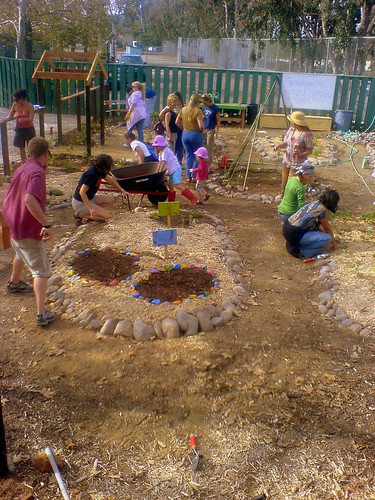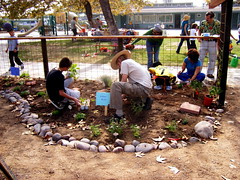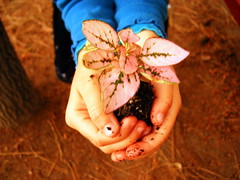Tuesday, November 27, 2007
Fruit Tree Inspiration
For more information, check out their website here.
Monday, November 19, 2007
A Toast to Compost!


Composting can be tricky, it can be fun, it can be messy, and it can be a great project for kids...and it most definitely is ESSENTIAL for the garden. So far we have one outstanding compost area set up with a stacking composter, a tumbling composter and a worm house, aka vermicomposter, donated by the Gibbons-Croft family and the Green family...these will help our garden thrive! We are working on setting up the same kind of thing over in the 3-8 garden but any help or donation in this area would be great!
Here's what we would like to happen to keep our compost healthy. We would like each classroom to have a pail for collecting scraps from kids lunches. Once a week those scraps can be tossed into the composter! Then we can water and turn the compost. We have included "watering the compost" twice a week to the list for the garden liasons and volunteers posted on the white board in the garden. A whole watering can should do the trick. The worms also need watering but not as much or as often.
What to Compost: melon rinds, carrot peelings, tea bags, apple cores, banana peels - almost everything that cycles through your kitchen. The average household produces more than 200 pounds of kitchen waste every year and we can successfully compost all forms of kitchen waste. Egg shells are a wonderful addition, but decompose slowly, so should be crushed. Coffee is an excellent addition to compost...the kids can bring it from home...many coffee shops also donate their grounds! And if your class participates in cooking projects, the veggie scraps are appreciated!
What NOT to Compost: No dairy products, and high-fat foods like salad dressings and peanut butter, can present problems ...also NO MEAT or CHEESE!
Garden Refuse can also be composted. All of the spent plants, thinned seedlings, and deadheaded flowers can be included. Most weeds and weed seeds are killed when the pile reaches an internal temperature above 130 degrees, but some may survive. To avoid problems we shouldn't compost weeds with persistent root systems, and weeds that are going to seed.
Managed Composting involves active participation, ranging from turning the pile occasionally to a major commitment of time and energy. We can get fully cooked and ready-to-use compost in 3-4 weeks if we water, feed, turn and tend our compost!
 Worm Composting (or vermicomposting) is different than traditional composting. Worm composting is a process that uses red earthworms, also commonly called redworms, to consume organic waste, producing castings (an odor-free compost product for use as mulch), soil conditioner, and topsoil additive. Naturally occurring organisms, such as bacteria and millipedes, also assist in the aerobic degradation of the organic material.
Worm Composting (or vermicomposting) is different than traditional composting. Worm composting is a process that uses red earthworms, also commonly called redworms, to consume organic waste, producing castings (an odor-free compost product for use as mulch), soil conditioner, and topsoil additive. Naturally occurring organisms, such as bacteria and millipedes, also assist in the aerobic degradation of the organic material.
Vermicomposting is especially useful for processing food scraps, since the worms consume the material quickly and there are fewer problems with odor. Worm composting does not generate temperatures high enough to kill pathogens. For this reason, vermicomposting is more appropriate for food, paper, and yard waste. Food scraps should be chopped or shredded for faster degradation. Unprocessed materials can be used in vermicomposting, but the time required for complete degradation of the organic waste is generally six months or longer.
It is up to our Teachers and Garden Liaisons to decide how into composting they would like to be...and we have more links and info for you as well as workshop information! If one or two teachers get inspired, certain classes could take over composting and do all the collection, temperature-taking, turning, and general maintenance. Other school gardening programs have had good results dealing with composting this way. There is a huge amount of curriculum and lesson plan's information out there for those of you that are interested!
Thursday, November 15, 2007
The Green is Spreading...





At last the 3rd-8th grade garden beds are getting planted! Hurray, it looks great! And good news...we are close to having water over there, if we don't already.
Many of the garden plans are moving right along in a positive way. We are working towards our shade structure goal, working on a plan to present to the school district. It is also important for us to get a good, workable system set up in each area for more efficient maintenance...in otherwords, we want everything to be where it should be...watering cans, trowels etc. Many of us have made that long trek across the blacktop just to realize we forgot the water key...
Hopefully, after the Thanksgiving break we will have some workshops listed for Teachers and Garden Liaisons to help everyone figure out how gardening is actually going to integrate into daily classroom activities. We are actively looking into great garden curriculum, lesson plan ideas for all ages and are hoping to find knowledgable folks to come in to work with all of us...teachers, kids everyone! We are very fortunate to have a Master Gardener (soon to graduate from the program) assigned to our school. She is a retired Teacher and Principal from Bay Park Elementary. She was and still is very active in the school gardens they have. You can read a bit about it here. She has so much knowledge and will be working closely with us in the future.

Next week a few of the Garden Liaisons and volunteers will be tending and watering our gardens, tree, vines, planter boxes etc. We are hoping that over the next break in December we will have even more help in this area from our SDCCS families! Keep the garden in mind as a volunteer/hours option.
Have a great holiday with your families everyone. We are thankful for our wonderful SDCCS community!
Tuesday, November 13, 2007
Kids in the Garden

Each of the Kindergarten, First Grade and Second Grade Classes have been having tours of the Garden this past week...
We tried to make it fun, introducing the good smelling herbs, (kitchen and medicinal) and gently touching them with two fingers...meeting the grape vine, the baby mandarin orange tree and the weeping mulberry tree. We discussed winter vegetables versus summer vegetables and the benefits of planting marigolds around them. Each child planted a sweet pea seed and made a wish...some did a few garden chores, protecting flowers by lining a path with stones...and everyone had the chance to whisper a secret to one special plant that they will keep an eye on all year and let us know if it needs extra care.
We ended each tour with a ring-around-the-tee-pee and a special chant that goes like this.. "inch by inch, row by row, I'm gonna make this garden grow!"

After all these magical tours, it felt as if each child made a connection with the space and learned a few garden rules; nice words spoken here, walking feet, keep the rocks on the ground, etc. Also, a bit about how to care and show respect to the plants in our special garden... and all growing things.
Here are a few "kid quotes" we collected while in the garden...
"I am talking to a plant now.." Ian
"The seed kind of cracks open and that's how it starts"... Katie
"Sweat Pea, That's what my Grandma calls me"... Alysah
They even came up with a few names for the Garden...
"The Garden Gate".... Bret
"The Love Plants".... Victoria

Thursday, November 8, 2007
Grades 3 thru 8, You're Next!!


Don't think the garden motivation stops here! Now that we have the K-2 garden well under way, we want to make the 3rd-8th grade garden a desirable destination as well! It is our goal to build some sort of shade structure with beams attached to planters (like the picture but not in cement!) with a trellis cover for the center of our raised bed area. We would love to have this done between Thanksgiving and Christmas. Hopefully this will attract all the teachers as an "outdoor classroom" area to be used for more than just planting, gardening and composting...but also hanging out, reading, breaking up into small groups, etc!
Our one obstacle to a flourishing garden in this area is water!! We thought we had that covered but we just found we have pipes that are in need of repair and a shut off valve that may be difficult to turn back on. We are working on this...and, in the meantime, we will have to use the spigot next to Jeff Plapp's classroom with a hose, watering cans and a wheelbarrow. We are hoping that enthusiastic Middleschoolers won't mind wheeling a watering can or two over to their thirsty plants. (maybe we could call this PE?) We know this is not ideal and have a work order out to the two Irrigation people who work for SD City Schools.
So...if anyone wants to help the 3rd-8th graders water once their beds are planted or if anyone wants to work on a guided building project, donate wood, time, or ideas...please contact Amy or Annie ASAP!
Tuesday, November 6, 2007
Garden Liaison's, What can you do ?

 Now that we have the K-2 Garden mostly planted, we have come up with a simple maintenance schedule to ensure that all the baby plants and seedlings have all the nourishment they need to prosper. After consulting our Teachers we have come up with these days for weekly watering that the children can be a part of.
Now that we have the K-2 Garden mostly planted, we have come up with a simple maintenance schedule to ensure that all the baby plants and seedlings have all the nourishment they need to prosper. After consulting our Teachers we have come up with these days for weekly watering that the children can be a part of.Monday is Miss Jen's First Grade Class
Tuesday is Miss Karen's Second Grade Class
Wednesday is Miss Morgan's Kindergarten Class
Thursday is Mr. V and Miss Kate's Multi Age Class
Friday is Jacob's Kindergarten Class
On these days the Teachers will bring their children out to do a bit of watering...mainly just the seedlings and the passion vines...and to throw out compost scraps and feed the worms. This is really just an opportunity for the Teachers to do a bit of gardening with the kids. This doesn't need to take more than 15 minutes unless they are in the mood for more!!
The rest of the watering for that day will be up to the Garden Liaisons to either do themselves, or coordinate a parent volunteer to spend about 40 minutes on your classrooms day tending to the garden. We will have a weekly calender on the white board in the garden that will list the daily chores. The chores will mostly be watering and everyone's favorite job, weeding. I am sure the children would love to pull weeds as well. Everyone will need to know the combination to the locked bench with the water key in it...and how to work that thing!! Amy will be in the Garden, this Wednesday and Friday after school to go over all the details, so please stop by. We do plan to incorporate some type of irrigation in the future, which will make watering a breeze.
So, if you are wondering what the overall responsibilities for a Garden Liaison will be, here's what we think...
A Garden Liaison will...
1) Find out how your child's teacher would like to integrate gardening into their plans for the year.
2) Choose a day of the week for classroom gardening projects and put up volunteer sign-ups for these jobs if the teacher wants help.
3) Put up a sign-up for parent volunteers for the once weekly maintenance...(for instance, water on Monday).
4) Keep an eye on the plants in your classes designated area...share information about the plants in your garden bed and pass it on to the kids.
5) Continue to check the Garden Blog for updates to pass onto teachers, parents, children, etc.
6) Keep classroom up-to-date about Garden Events via bulletin board or class newsletter and keep Garden Committee up-to-date about classroom garden interests as they evolve.
7) Encourage other activities with the help of parent volunteers involving the garden...sketching plants in the garden...cooking and eating...perhaps learning about medicinal herbs...look into stories or folklore involving certain plants. For a great resource for gardening lessons and activities click on this link here. This is also a link in the Education Bar in the upper left hand corner, Kids Gardening.
8) Keep track of watering cans and tools and return them to garden!
9) If this seems like a lot...you may decide to make it a two person job! Either way it will be a very enjoyable way to spend your volunteer hours.
We hope the garden will enhance the school experience, not take away volunteers from teachers in much needed areas...hopefully the position of Garden Liaison will help the Teachers, maybe provide them with more time for small groups, etc.
As always, suggestions are appreciated in the comment section!!
Sunday, November 4, 2007
The First Planting Day!

What a great success!
Watching SDCCS families plant together and work as such a fabulous Cooperative was a beautiful sight to see! Key ingredients: Good Food, Good Art, Motivated People,
and a Fine Display of Creative Energy!
We look forward to many bountiful, green days to come with our entire community. THANK YOU EVERYONE!
And now, let's let the pictures do the talking!
( If you would like to see more photos from the day click here, and go to our SDCCS Garden Flickr group.)
We hope to see you in the garden soon!



Thursday, November 1, 2007
Garden Festival, Sunday November 4th!!
a little gardening 101...
 We have many experienced gardeners at SDCCS and some who have self-proclaimed "brown thumbs" but most of us live somewhere in- between...
We have many experienced gardeners at SDCCS and some who have self-proclaimed "brown thumbs" but most of us live somewhere in- between...Over the next couple of weeks and throughout the year, teachers, garden liasons and parent volunteers will be planting all sorts of veggies, herbs, trees, vines, seeds and flowers with our kids and maybe now is a good time for a refresher about the basics. First, a few definitions...
topsoil: the good dirt for our plants (not hardpan or clay or sand etc)
compost: decomposed plant matter that acts as food for the plants and earthworms
mulch: usually chipped bark used to hold in moisture...it covers the soil after planting, helps keep out weeds and keep in water... good for paths and walkways
6 pack (not the drinking kind or the muscle kind): 6 small plants sold together...the containers will be reused for seedlings
thinning: kind of obvious, but after you plant seeds... many of them so tiny its hard to sprinkle only a few... too many will sprout in one place and thinning is necessary for the plants to grow without overcrowding
pruning: cutting back a plant so it will grow bushier and healthier
dead-heading: snapping the dead flowers off a plant so all that growing energy can go into making more flowers/seed etc
companion planting: a method of planting that pairs kinds of veggies, herbs and flowers so their different properties can help eachohter thrive...for instance, some plants grow tall and shade seedlings that can't take full sun...or certain flowers keep snails away...or certain plants attract ladybugs that will eat aphids and white flies...and of course the reverse is true, and some plants do not do well next to others...onions can be tricky as can garlic and fennel.
OK, now a bit about planting...
When you are planting vegetables, herbs, and flowers it is best to squeeze and bend the plastic planter they are in to loosen them...if they are root-bound (in otherwords, the roots are a clumped together and often still in the shape of the planter...) it is necessary to rip off the bottom 1/4 of the root system. I know it sounds drastic but it will help the plant to drink right away and adapt to its new home.
It's also good to give your newly planted plants a gentle watering and be diligent about watering until they are established. And be prepared to weed a lot...make sure you have marked well the areas where you are expecting seedlings and try to differentiate between them and the weeds.
It is important to know enough about your plant to space them the proper distance...tomatos get huge, radishes not so much etc. Here's a good list for vegetable spacing but more research is necessary for many of the medicinal and culinary herbs that will be planted.
Veggie Spacing Guide
Asparagus 15-18 inches apart

Beans, lima 4-6
Beans, pole 6-12
Beans, bush 4-6
Beets 2-4
Broccoli 12-18
Brussel sprouts 15-18
Cabbage 15-18
Potatoes 10-12
Pumpkins 24-36
Radishes 2-3
Rutabaga 4-6
Collards 12-15
Squash, summer 18-24
Squash, winter 24-36
Sweet corn 15-18
Turnips 4-6
 Lettuce, head 10 to 12 inches apart
Lettuce, head 10 to 12 inches apartSouthern pea 3-4
Spinach 4-6
Eggplant 18-24
Kale 15-18
Tomatoes 18-24
Leeks 3-6
Onion 2-3
Pumpkin 24-36
Cucumber 18-24
Expect a bit of time where the plants look great...then not so great a couple of days later...and then hopefully, great again!
Happy Planting...and comment if you have questions or quick tips!










